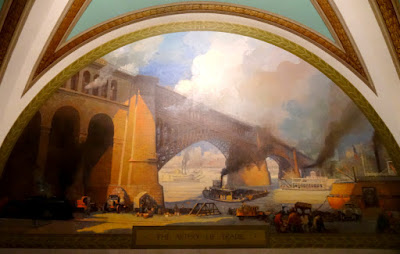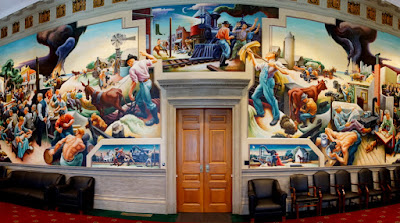It was about a 53-mile drive from our campsite at Lake of the Ozarks State Park in Brumley, MO, to the Missouri capital. It was not likely we would be any closer for a while so we headed to Jefferson City for the day. Our timing could have been better. Unfortunately, they were well into a restoration project on the exterior of the building so the Capitol looked more like a farm silo than the elegant seat of the state government.
Lewis and Clark, Corps of Discovery, sculpted by Sabra Tull Meyer
I'm sure when the restoration is complete it will be beautiful but today there was not much point in exploring the grounds. There were a few interesting sculptures and fountains but the warm day and humidity made it an easy decision to head indoors.
Joani's research indicated the capitol contained a lot of public art. We now know they meant murals and bronze busts on display not framed art you would find in a museum. There were, however, some very nice murals. Our tour was led by an enthusiastic docent who had lots of history behind the artwork.
In 1911 the previous capitol was destroyed by fire. The state’s voters approved a bond issue to finance construction of the current Capitol. They were hoping to raise 3.5 million but instead raised 4.3 million. When the building was completed in 1917, it was determined the surplus (nearly 1 million) must be used on the Capitol so some of the leading artists of the day were hired to paint murals. On the second floor, a collection of 41 lunettes (arched-shaped paintings) depict Missouri’s history. Each measures about 12 feet by 6 feet.
The Father of Waters, by Frank Nuderscher 1922
The Father of Trade, by Frank Nuderscher 1922
The rotunda was nice but the lighting made it nearly impossible to do it justice in photos.
We learned the Missouri coat of arms included two grizzlies holding the shield, not because there were a lot of grizzlies in the area (there were never grizzlies in Missouri) but because someone thought they gave the impression of strength and courage. The crescent moon in the crest represented the second son. Missouri was the second state established from the Louisiana territory purchased in 1802.
Great Seal of Missouri was designed in 1822 by Judge Robert Wells
Motto Translation: "Let the welfare of the people be the supreme law."
A Social History of the State of Missouri, by Thomas Hart Benton
completed in 1936, egg tempera on canvas
completed in 1936, egg tempera on canvas
The most popular piece of art in the Capitol (popular today, but not in 1936 - the Representatives hated it with a passion.)
We heard our guide say Benton used 36 dozen eggs (to make the egg tempera paint in the process of painting this room, but that can not be right - 3,600 or 36,000 maybe by I can't believe 420 eggs.
The first floor of the Capitol is a museum devoted to Missouri's history.
Senate Gallery
Cladochonus, Tabulated Coral on the 4th floor, in the floor across from room 406



















No comments:
Post a Comment